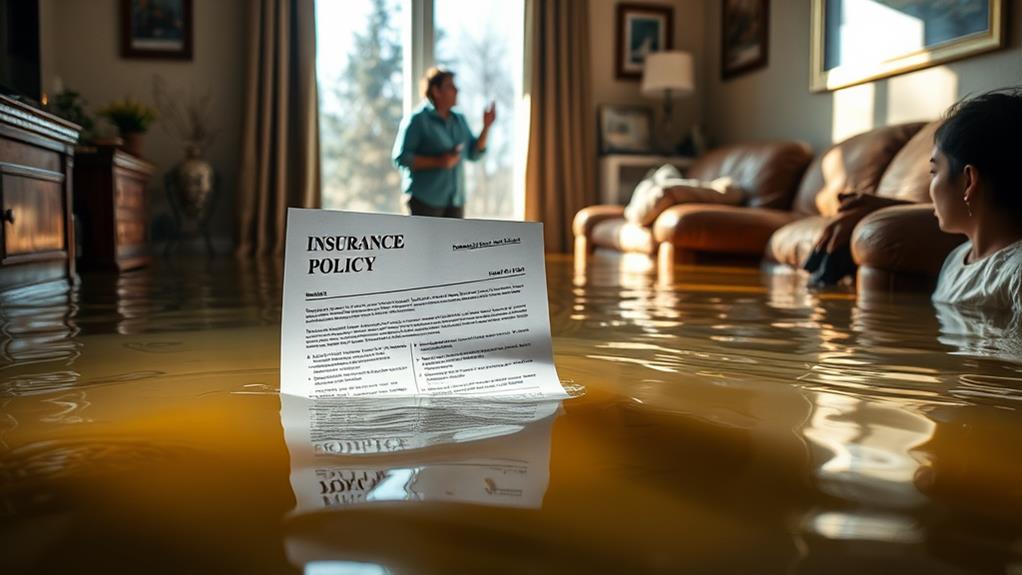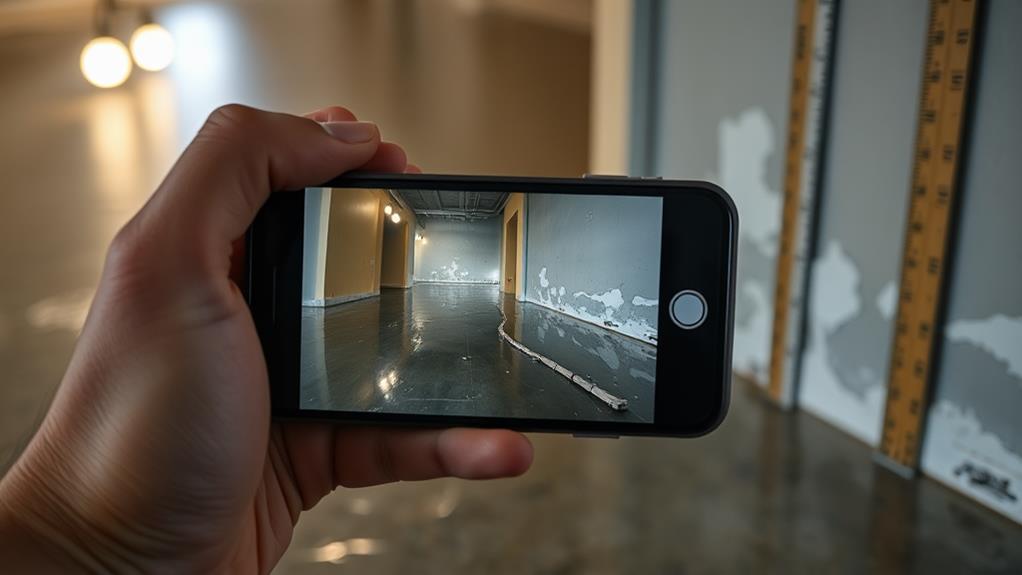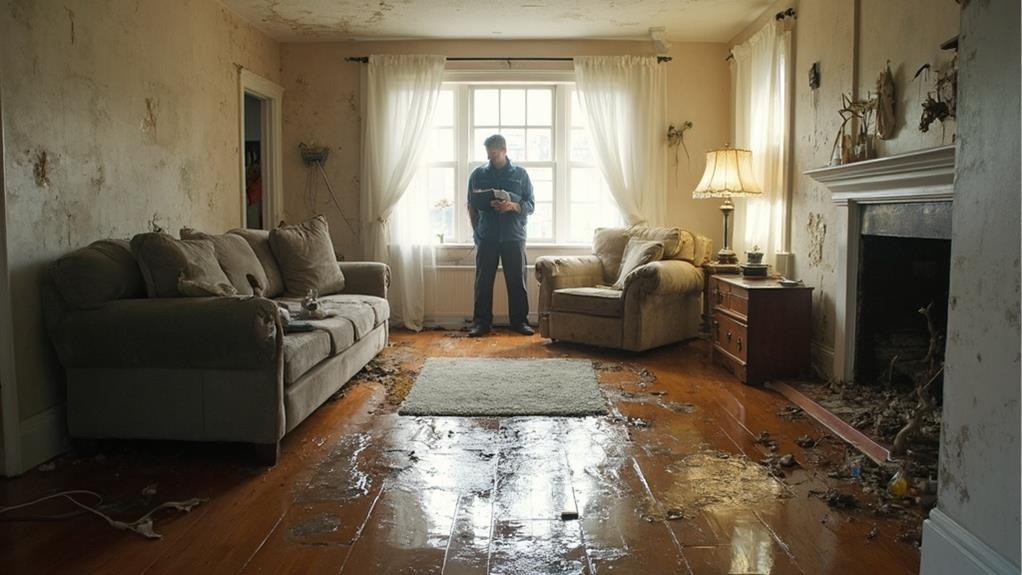Dealing with standing water damage requires prompt action and a thorough understanding of your insurance policy. Homeowners should immediately document the damage with photos and videos, create an inventory of affected items, and contact their insurance provider. It's crucial to review policy documents, focusing on water damage coverage and exclusions. Working closely with insurance adjusters, obtaining professional estimates, and hiring reputable restoration contractors are key steps in the claims process. To prevent future incidents, regular home inspections, maintenance, and implementing preventive measures are essential. Exploring the complexities of water damage claims can significantly improve your chances of a successful resolution.
Understanding Your Insurance Policy

Three key steps are essential when it comes to understanding your insurance policy in relation to water damage claims. First, thoroughly review your policy documents, paying close attention to the sections on water damage coverage, exclusions, and claim procedures. Familiarize yourself with the types of water damage covered, such as burst pipes or storm-related flooding, and those excluded, like gradual leaks or neglect.
Second, consult with your insurance agent or broker to clarify any ambiguities or complex terms in your policy. Ask about specific scenarios and how they would be handled under your current coverage. This conversation can help identify potential gaps in your protection and guide decisions on additional riders or endorsements.
Lastly, keep your policy updated to reflect changes in your home's value, renovations, or new water-related risks. Regularly reassess your coverage limits to ensure they align with current replacement costs. Understanding these aspects of your policy will empower you to make informed decisions when filing a water damage claim and help minimize potential disputes with your insurance provider.
Types of Standing Water Damage
Standing water damage can be categorized into three distinct types, each presenting unique challenges for homeowners. The first type is clean water damage, resulting from sources such as broken pipes, overflowing sinks, or rainwater. While generally the least hazardous, clean water can still cause significant structural damage if not addressed promptly.
The second type is gray water damage, which involves contaminated water from sources like washing machines, dishwashers, or toilet overflows without feces. This water may contain chemicals, bacteria, or other contaminants, posing health risks and requiring more thorough cleaning and disinfection.
The third and most severe type is black water damage, caused by sewage backups, flood waters, or standing water that has become heavily contaminated. Black water poses serious health hazards and often requires professional remediation. It can harbor dangerous pathogens, bacteria, and toxic substances.
Each type of standing water damage requires different approaches to cleanup, restoration, and insurance claims. Understanding these distinctions is crucial for homeowners to effectively communicate with insurance providers and restoration professionals, ensuring appropriate coverage and remediation efforts.
Documenting the Damage

Proper documentation of water damage is crucial for a successful insurance claim and effective restoration process. Begin by taking detailed photographs and videos of all affected areas, including close-ups of damaged items and wide shots of entire rooms. Capture images before any cleanup efforts to accurately represent the extent of the damage.
Create a comprehensive inventory list of damaged belongings, including their estimated value, age, and condition prior to the incident. Keep all receipts related to temporary repairs, emergency services, or replacement items. Document conversations with insurance adjusters, contractors, and restoration professionals, noting dates, times, and key points discussed.
Maintain a detailed timeline of events, starting from when the water damage was discovered and including all subsequent actions taken. Record moisture levels in affected materials using a moisture meter, if possible. Preserve samples of damaged materials, such as carpet or drywall, as evidence of the extent of the damage.
Filing Your Insurance Claim
With thorough documentation in hand, the next step is to initiate the insurance claim process. Contact your insurance provider as soon as possible to report the water damage incident. Most insurers have a 24/7 claims hotline or online portal for immediate reporting. Be prepared to provide your policy number, a brief description of the damage, and the date it occurred.
Your insurance company will assign a claim number and an adjuster to your case. The adjuster will schedule an on-site inspection to assess the damage firsthand. During this visit, present your documented evidence, including photos, videos, and itemized lists of damaged property. Be honest and transparent about the extent of the damage and its cause.
After the inspection, the adjuster will prepare a report detailing their findings and estimated repair costs. Review this report carefully and discuss any discrepancies with the adjuster. If you disagree with the assessment, consider hiring a public adjuster to represent your interests. Once you and the insurance company agree on the claim amount, you'll receive a settlement offer. Carefully review the terms before accepting, ensuring it covers all necessary repairs and replacements.
Working With Insurance Adjusters

Insurance adjusters play a crucial role in the claims process, serving as the primary liaison between you and your insurance company. When an adjuster is assigned to your case, prepare for their visit by documenting all damage thoroughly with photos and videos. Create a comprehensive inventory of damaged items, including their estimated value and purchase dates.
During the adjuster's inspection, be present to point out all areas of concern and provide any additional information they may need. Be honest and straightforward in your communication, avoiding exaggeration or understatement of the damage. Take notes during the visit and ask questions if anything is unclear.
After the inspection, the adjuster will prepare a report detailing their findings and estimated costs for repairs. Review this report carefully and compare it to your own documentation. If you disagree with any aspects of the report, communicate your concerns promptly and provide supporting evidence. Remember that you have the right to obtain independent estimates from contractors or public adjusters if you feel the insurance company's assessment is inadequate. Keep all communication with the adjuster in writing and maintain a record of all interactions throughout the claims process.
Restoration and Repairs
Once your insurance claim has been approved, the restoration and repair process can begin. This phase is crucial for returning your home to its pre-damage condition. Start by hiring reputable, licensed contractors specializing in water damage restoration. These professionals will assess the extent of the damage and develop a comprehensive repair plan.
The restoration process typically involves several steps: water extraction, drying, dehumidification, cleaning, and sanitizing. Industrial-grade equipment like powerful pumps, air movers, and dehumidifiers will be used to remove standing water and moisture from your property. After thorough drying, damaged materials such as drywall, insulation, and flooring may need to be removed and replaced.
During repairs, address any structural issues caused by water damage. This may include reinforcing weakened foundations, replacing rotted wood, or repairing compromised electrical systems. Mold remediation is often necessary to prevent health hazards and further property damage. Finally, cosmetic repairs like repainting, installing new flooring, and replacing damaged fixtures will restore your home's appearance. Throughout this process, maintain open communication with your insurance company and document all repairs to ensure proper coverage and reimbursement.
Preventing Future Water Damage

Proactively addressing potential water damage risks is essential for homeowners to avoid future insurance claims and property destruction. Regular maintenance and inspections can significantly reduce the likelihood of water-related issues.
Start by examining your roof for damaged or missing shingles, and ensure gutters and downspouts are clear of debris and properly directing water away from the foundation.
Inside the home, check plumbing fixtures, pipes, and appliances for leaks or signs of wear. Install water leak detection devices near prone areas such as washing machines, water heaters, and dishwashers. Consider upgrading to water-resistant materials in bathrooms and kitchens, such as tile or vinyl flooring.
Proper landscaping can also play a crucial role in preventing water damage. Ensure the ground slopes away from your home's foundation, and consider installing a French drain system if necessary. Trim trees and bushes near the house to prevent root intrusion into pipes or damage to the structure during storms.
Lastly, educate family members on the location of the main water shut-off valve and how to use it in case of emergencies. By implementing these preventive measures, homeowners can significantly reduce their risk of future water damage and costly insurance claims.
Frequently Asked Questions
Can I Stay in My Home During Water Damage Restoration?
Staying in your home during water damage restoration depends on the extent of damage and restoration process. Safety concerns, air quality issues, and practical limitations may require temporary relocation. Consult with restoration professionals for specific advice regarding your situation.
How Long Does It Typically Take for an Insurance Claim to Process?
Insurance claim processing times vary depending on the complexity of the claim and the insurer. Generally, straightforward claims can be processed within 1-2 weeks, while more complex cases may take several weeks to a few months to resolve.
Will Filing a Water Damage Claim Increase My Insurance Premiums?
Filing a water damage claim may potentially increase your insurance premiums. Insurers often view claims as indicators of future risk, which can lead to higher rates. However, the impact varies depending on your policy, claim history, and insurer's practices.
Are Mold-Related Issues Covered in Standard Water Damage Insurance Claims?
Standard water damage insurance claims typically do not cover mold-related issues. Many policies exclude mold damage or offer limited coverage. Homeowners should carefully review their policy or consider purchasing additional mold coverage for comprehensive protection against water-related damages.
Can I Choose My Own Contractor for Repairs After a Claim Is Approved?
Like Odysseus choosing his own path, homeowners often have the right to select their preferred contractor for repairs after an approved claim. However, it's essential to consult your insurance policy and adjuster for specific guidelines and limitations.
Conclusion
In the grand ballet of insurance claims, homeowners pirouette through policy piranha, dodging exclusions and deductibles with the grace of a soaked cat. As adjusters waltz in, wielding clipboards like swords, the water-logged masses cling to their mold-infested possessions, praying for coverage. This soggy saga concludes with a symphony of industrial fans, leaving behind a cautionary tale: in the aquatic circus of homeownership, only the most prepared stay afloat.

